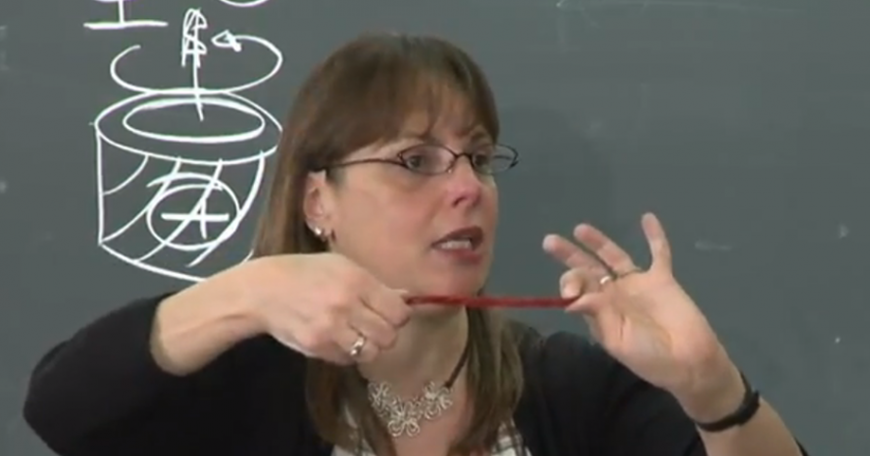Symbiosis Between In-class & Online in Mechanics & Materials

Digital learning informs and improves face-to-face teaching.
Dr. Simona Socrate’s Mechanical Engineering course is a compelling illustration of the power of digital learning to inform and improve face-to-face teaching.
In addition, traditional face-to-face modalities provide a seedbed from which MOOCs will grow. Socrate was one of the first MIT faculty to use edX to create a MOOC. Over the course of several semesters, the symbiotic nature of the relationship between her MOOC and her residential course emerged, with each enriching and impacting the other.
In the spring of 2013, Socrate gave her Mech E-course (2.01) using traditional teaching tools such as a textbook, problem sets, and online pdfs. She also videotaped her lectures. The ensuing summer (2013) Socrate presented the same course as a MOOC: a completely online experience using videotaped lectures and problem sets from the previous semester. Socrate also created additional instructional (tablet) videos and ‘whiteboard videos’, as well as very detailed interactive solutions for a large range of example problems. In addition, Socrate embedded several digital technologies into the MOOC platform such as MATLAB and an FE Solver based on the Akselos platform.
Interestingly, the materials that Socrate created for her MOOC proved remarkably useful for the next residential iteration of her course. The MOOC materials were of extremely high quality and accuracy, and Socrate integrated them into her residential course with the result of a more efficient, rich, and well-supported learning experience for her MIT students.
When the students watched the videos between lectures, they came to class more curious; they understood concepts better with a video introduction. Lecture videos were also useful for reviewing later in the semester in preparation for tests. Individuals in need of extra assistance used the online materials for supplemental help. Socrate could identify where a specific student was struggling and recommend various tools, videos, etc., tailored to their pedagogical needs.
The repository of interactive solutions that Socrate and her staff created for the MOOC proved invaluable to the residential students in regards to homework and problem sets. The online exercises offered immediate feedback and provided an interactive learning experience. Instead of waiting up to 2 weeks to look at their graded problem sets to find out if they were on track with the material, students promptly learned where they were right or wrong, able to try again with the concepts fresh in their minds.
The interactive online problem sets also changed the nature of office hours. Students brought their laptops and TAs helped them through the problems in a collaborative hands-on process.
“The whole class is less stressed out, including me.” [Socrate]
With an abundance of online materials available in Socrate’s course, class time was more fluid. If a student asked a question, Socrate could spend time on the explanation as well as refer students to additional material online. Relieved of the pressure to cover everything during class, Socrate could be more responsive and spontaneous with her students. "The whole class is less stressed out, including me," says Socrate.
Socrate’s approach embodies elements of the flipped classroom, where students’ pre-class preparation frees up time for student-centered interactions during class. But this means students must attend class: Socrate’s face-to-face lectures contained information not covered elsewhere. Although Socrate shared her lecture notes after each class, she did not post lecture videos until just before exams.
The preparatory work involved in creating Socrate’s MOOC in its first year was intense. The edX platform required consistent procedures and a high level of organization and planning. In addition, consideration of pedagogical purposes and goals had to be interwoven into the platform’s structure and architecture. Socrate worked with a skilled MOOC team comprised of ODL staff, undergraduate and graduate TAs, graphic artists, and domain experts. After the first year, the preparatory work decreased dramatically. Now, Socrate has a digital repository of learning exercises and homework problems, which can be easily adapted and modified to fit the current run of her course. In addition, previous videos give Socrate a good approximation for how long it will take to teach something, as well as how the various conceptual modules can be organized.
Student response has been overwhelmingly positive, with the updated residential course being described as a ‘well-oiled machine’. Many students took 2.01 as a tester class to see if they liked Mech E and many decided to major in Mechanical Engineering after taking the class.
Looking towards the future, Socrate would like to deepen her students’ learning experience by adding more conceptual questions interspersed with the videos. By placing them at the beginning and end of a learning sequence, the questions could serve to awaken curiosity as well as to gauge understanding of the material. The MOOC can be a useful resource for testing out innovations such as this that will, in turn, enhance the residential experience.

